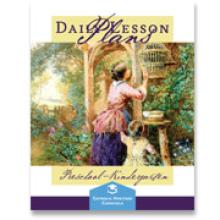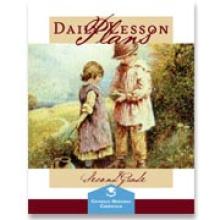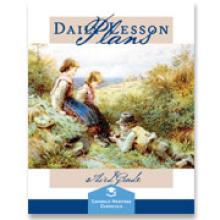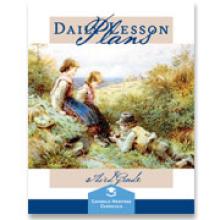No name
Preparing your Child for Baptism
CHC Lesson Plans
After receiving the new Catholic Heritage Curricula (CHC) lesson plans a few weeks ago I was so excited I dropped the program that I had designed for our younger daughters and began using the CHC plans. They are thrilled and I'm overjoyed to find such complete, yet flexible, plans that are thoroughly Catholic.
Are you looking for a program to keep you on target yet one that is flexible? These are the plans for you. Do you use an educational approach that focuses on living books and the beautiful in life or do you prefer the classical approach with a solid grounding in the basics suitably arranged by the child's ability with a focus on memory work? These plans will work for you too. If you prefer textbooks and workbooks the CHC lesson plans includes all the core assignments in an easy to use format. Not only are these plans complete and flexible, but they contain dozens of ideas and tips from experienced Catholic homeschool mothers that make teacher preparation and the learning experience exciting yet simple. I'm so impressed with these plans that I'm ordering a set for my godson and will be modifying the first grade plans again next year to use with my older children (they are that flexible!)
CHC surveyed dozens of families to determine what they wanted in lesson plans and then they designed plans that are simple, but at the same time deep and inspiring. The plans are easy to follow and use low cost, high quality material. The authors have done an impressive job integrating the material around science or social studies topics, the liturgical year or an approaching holiday. Not only are these plans easy to work with (including space to fill in your own assignments if you wish) but they are attractive to the eye, charming, quaint and best of all thoroughly Catholic. I'm amazed! These are not plans you'll dread using because they don't reflect the drudgery that often goes along with lesson plans, but rather they offer a spark of excitement through wonderful ideas, charming illustrations to raise the spirit and reflections that offer hope and encouragement.
The CHC Lesson Plans for both Kindergarten and the First Grade contain all the necessary features to help the parent/teacher quickly and easily make use of the plans. The "Frequently Asked Questions" section addresses common concerns with answers that are fresh and inspiring. "Educating For Eternity" follows the Q/A section and includes a typical course of study, goals, and a subject guide (overview of the material and it's best use.)
The lesson plans themselves include a weekly teacher's guide followed by the assignment plan. The Teacher's Guide in the First Grade lesson plans cover two pages for each week. Each core (and some non-core) subject heading is followed by innovative suggestions and tips for not only teaching the material but also ways in which our Holy Faith can be naturally woven into the teaching of that subject. These two pages also contain quaint illustrations that can be included as part of the students learning experience, illustrated hands-on religion projects, space for the teacher to note daily practice work, a brief excerpt from spiritual writings to set the tone for teaching religion that week, and a weekly goal chart with the overall assignments broken down by subject. This weekly goal chart provides flexibility for families who prefer to use an approach other then day-to-day assignments.
The Teacher's Guide is followed by a two-page daily assignment table (day of the week by subject) for those who prefer assignments broken down by page number. Core subjects are shaded so the teacher can quickly determine what material is essential. This feature makes personalizing the plans simple as non-core subjects can be done on the day assigned or saved for later. The assignment table set-up is unique in design with lined space available around the table allowing extra work, enrichment activities, appointments, etc to be added. The Kindergarten plans have similar features with the exception that the teacher's guide occurs alongside the daily assignment table.
Finally, the lesson plans are followed by appendices which include supplemental activities (I wish I had used these with my older children), monthly planners, chore charts (illustrated for non-readers), certificates (beautiful), and resource lists.
The materials used within these plans are all excellent products used by many families (including our own) for years. I am so very impressed by the plans that I will be permanently dropping the lesson plans I designed for our children to use CHC plans. These plans are worth two or three times the price and are truly unique.
Copyrights 2002-2006
Daily Lesson Plans: Preschool-Kindergarten
CHC Lesson Plans: First Grade
The First Grade Lesson Plans are similar in format to the Kindergarten Lesson Plans except that they offer a lot more as your child becomes more immersed in school. Now there are four pages dedicated to each week of lessons. the first two pages provide a parent's preparation check list, weekly goals, overviews of week's assignments and much more. The layout is both beautiful and easy-to-use. The final two pages for the week are a planner-format lessons chart with ample room around the edges for notes, additions, changes, etc. The lesson plans are organized around a four-day work week, allowing families to plan a special day for field trips, family activities, house cleaning, or just catching up.
The basic texts used are: Little Stories for Little Folks (Catholic Phonics Readers), My Very First Catholic Speller, MCP Math Level A, the New Catholic Picture Bible by Fr. Lovasik, Faith and Life Book One, A Year With God: Celebrate the Saints Throughout the Year, Easy as 1,2,3,: A Catholic Overview of Science, Writing Can Help by Marie Picard, Art with a Purpose, Our Musical Year and Fun Physical Fitness for the Home. Recommended supplemental materials, great children's stories for reading practice and beautiful character-building cards are also included. Very impressive!
New Revised Edition: The new Revised Edition of the First Grade Lesson Plans (available Fall 2002) includes the following improvements: Page numbers updated to correspond with the revised edition of Faith and Life Activity Book, Grade 1, "Year At-a-Glance Chart" for ease of planning (pages 30-31), "Read-Aloud List" for locating read-alouds each week (pages 32-33), "Art Appreciation List" for locating art masterpieces each week (page 34), alternate illustrated chore chart (page 187), Larger character-building cards in Appendix Two for ease of use, updated resource section (pages 212-220) new additions to the "Frequently-Asked Questions and Answers", Revised selections for art appreciation (ones that are easier to locate), page numbers added to the lesson plan. The revised edition is 220 pages (compared to the previous 195), but the price is unchanged at $24.95.
This title was donated for review by Catholic Heritage Curricula.
CHC Lesson Plans: Second Grade
I continue to be impressed with each new grade level of the Catholic Heritage Curricula lesson plans. I could not imagine a more family-friendly format and the details are so impressive. On each two-page spread (which covers one week) there is a little "ideas" section which includes suggestions for celebrating feast days, an art masterpiece to display each month, and other things which help tie things together nicely. I love the beautiful quotes, simple games and other tidbits scattered throughout the lesson plans. The appendix includes an extensive religion supplement and resource especially designed for First Holy Communion preparation. Basic topics covered in this appendix are: Holy Manners, the Saints, Prayer, Reconciliation, Holy Mass and Preparing Our Hearts to Receive Jesus. A second, smaller appendix entitled "Tour the Continents: Learning About Other Lands and Peoples" offers a Catholic social studies course in conjunction with an encyclopedia set and a few other supplements.
The basic texts used are: Devotional Stories for Little Folks by Nancy Nicholson, American Cardinal Reader 2, My Catholic Speller A, Language of God for Little Folks A, MCP Math B, Faith and Life 2, Catholic Stories from Science 2, Map Skills A, Art with a Purpose, Writing Can Help 2, Fun Physical Fitness for the Home plus supplemental texts and educational materials included right in the lesson plans.
This title was donated for review by Catholic Heritage Curricula
CHC Lesson Plans: Second Grade - Science
I love homeschooling and am fascinated with science but frankly I've been pulling my hair out over the past few years trying to keep up with what I'm "supposed" to be doing with science.
Let's see, first my children are to be drawn into the topic through stories that the child will find captivating (Charlotte Mason.) Next they are to memorize facts related to the topic and "think" about it logically (Classical method) and also conduct experiments (hands on.) Finally the little ones are to pull it all together in a journal or lab manual in order to consolidate it in their minds and truly make it their own. The parent-teacher is also to organize these science activities in a logical way and carry them out while simultaneously teaching her other children who also have their own captivating home-grown science programs.
With all these challenges it's little wonder many of us have let science fall to the way-side or have reverted to boring, lifeless textbooks. I'm excited to say that this won't be the case for our younger children anymore. Catholic Heritage Curricula Grade 2 Lesson Plans pull together what will be for many families the ideal science program. Using just two easy to use books, Easy As 1, 2, 3 Science Overview and Catholic Stories from Science 2, the authors have woven a science program that: draws the student into the topic through interesting stories, provides factual information to be discussed and learned, offers links with real life events and experiments, and relates all matters back to God.
Catholic Stories from Science is in a larger and more readable format then the first edition. Each story immediately captures the attention of the student by using events that are in their everyday life. For example, the complicated topic of pheromones is made simple by telling a story about a family cat who marks his territory (and do you know how it is that God has marked you?) Who would have guessed that exocrine glands could be so interesting! After the students interest is caught the author provides detailed factual information that provides a firm foundation for later science studies.
These stories are paired with assignments from Easy As 1, 2, 3. At first glance, this book appears too simple to be helpful, but in reality it is extremely clever for it has broken into chunks the important aspects of science, working first from the most fundamental level, while at the same time providing discussion prompts to encourage the child to "think" about the topic rather then just memorize and regurgitate. How does this play out in the real homeschool. In one of the first weeks of the lesson plans we see that the child is reading a chapter about the physical make-up of an animal in Catholic Stories from Science. During that same week he is assigned the grade appropriate plan in Easy As 1, 2, 3 which instruct him as to a particular family of animals to study (e.g. carnivores.) The family makes use of their own library to read more about that animal family and then follow the suggestions in Easy As 1, 2, 3 for activities such as making comparison charts or tracings along with simple experiments. For the family that wants more experiments specific assignments from Everyday Science Sourcebook are offered. Toward the end of the week the child begins to pull the material together through discussions with his parent-teacher using the discussion prompts in Easy As 1, 2 3. These thoughtful prompts range from questions about the usefulness of the way the animal was designed to thinking of ways that God's faithfulness is seen in the organization of the universe.
So many science programs skip around from topic to topic or start at a high level without offering the fundamental information that serve as the building blocks for higher level science studies. After ten years of creating my own lesson plans I'm delighted with the CHC plans and am especially pleased that the second grade science plans provide structure within which science is connected with real life experiences. Thank you, Catholic Heritage Curricula; this summer will see me laughing in the fields with the children and not inside, cramped over a notebook amidst a pile of science books that refuse to give up the perfect lesson plan.
Catholic Heritage Curricula Lesson Plans: Third Grade
Do you remember third grade? I do – the field trips, the reading everything on which I could get my hands, the multiplication tables and pride when I had done all the way from zero to 12. Third grade is a marvelous year – independent learning starts and reading really takes off. Critical thinking, composition and communication skills broaden and strengthen. But, how does a home school parent ensure creating an environment that allows for these skills to grow, that encourages independence while nurturing?
Theresa Johnson’s CHC Lesson Plans: Third Grade (revised 2006) may just be the answer! Johnson encourages the parent to allow the third grader to keep his own study chart while the parent monitors progress. The third grader is given a list of weekly tasks in all subject areas, including some suggested wonderful books to read for pleasure, and the parent can adjust as necessary. In CHC Lesson Plans: Third Grade, you get all the subjects covered: math, reading, spelling, grammar, religion, science, social studies, handwriting and the fine arts. Each subject is laid out for each for the entire school year, with a different presentation for the independent learner and a more-detailed plan for the parents.
One of my favorite parts of any of the CHC Lesson Plans is the supplemental material that CHC provides in addition to the actual lesson plans. CHC Lesson Plans: Third Grade (revised 2006) includes many extras such as the age-appropriate and curriculum tie-in “Memory Gems” –short quotes or poems that the student can memorize, recite or copy into her own journal. Longer poems or quotes are also suggested and included in the plans.
Usually, third graders are becoming more fluent with their reading – to encourage this, CHC Lesson Plans: Third Grade (revised 2006) includes not only a wonderful age- and topic-appropriate reading list, but also some fantastic suggestions for creative book reports including creating movable dioramas, writing newspaper articles based on “interviewing” a book’s main character, scripting of a pivotal scene from the book and other ideas. There is also a section for the reader to keep track of the different genres read throughout the year – adventure stories, folk tales, lives of the saints, and others. This is a great way for kids to expand their reading and taste-test some different types of books.
Because CHC is a Catholic publisher, there is always a wonderful religion program included in their lesson plans. In CHC Lesson Plans: Third Grade (revised 2006), there is an amazing and creative rosary project titled, “At the Feet of Mary”. Notebooking pages, beautifully illustrated with original sketches, are also included.
For Social Studies, CHC has created a “Tour a Country: Learning About Other Lands and Peoples” project for the student to work on throughout the year. Basically, the student “travels” to a different country each month and completes notebooking pages and activities to “own” the information he learns about each country and its inhabitants. Reproducible pages make this a keepsake project for your world traveler!
The final extra in this lesson plan is a packet of suggested “Catholic Math Activities”. These are great ideas for living math, but the Catholic aspect can be a bit of a stretch. But this doesn’t reduce the value of these ideas – many different and creative ways for the third grader to embrace math as a fun and exciting subject, not just memorization of math facts.
Overall, I like the CHC plans the best of most of those on the market that I’ve reviewed. I don’t follow them slavishly but adjust as I see fit for my children. I can’t wait to “do” 3rd grade this year with my son, thanks to CHC’s lesson plans! By the way, most of the resources suggested in the lesson plans are also available from CHC's web site – I LOVE one-stop shopping!
Catholic Heritage Curricula Lesson Plans: Third Grade - Supplements
The supplements are carefully woven into the third grade lesson assignments, but for those who prefer not to use the lesson plans the supplements alone could easily be used for enrichment and would make purchasing the plans worthwhile. For example the book report supplements contain clear guidelines for helping young students write book reports, a checklist to help the student in their efforts, creative ideas for written reports or oral reports and hands-on project reporting. There are over 20 beautifully illustrated forms to be used for writing the reports or keeping track of books that have been read. These are not the normal squares and circle forms on the market, but are ruled pages containing illustrated borders depicting Victorian, Catholic and nature scene which would appeal to the eyes of both children and adults. Book report books comparable in length sell for about $6.99.
In addition to the book report supplement, the plans include a series of reading comprehension pages. Once again the pages are visually attractive to the student and they focus on questions designed to encourage beginning literary analysis as well as the usual comprehension type questions. These pages are based on three outstanding books: Catholic Tales for Boys and Girls, More Catholic Tales for Boys and Girls, The Little Apostle on Crutches. Almost 50 pages in length, this supplement is comparable to workbooks that sell for about $8.99 with the added feature that they are Catholic and clever in their design.
"At the Feet of Mary: Holy Rosary Project." is the most beautiful introduction to the rosary that I have seen. It is designed as a hands-on project to bring the faith to life. Each week the child focuses on a different mystery through discussion, readings from a lovely description of a child's trip to shrines, the coloring of gorgeous illustrations that form part of a prayer book and meditations that are clearly explained. The prayer book that the child makes includes illustrations that will touch the heart of a child because they depict the Mysteries as seen through the eyes of a child. At the end of this 5 week project the child has produced a gorgeous prayer book. This supplement is 65 pages long and nothing on the market even remotely compares to the depth and beauty found in this project, but books on meditating, understanding the rosary and illustrations on the rosary combined would stand at about $15.95.
The fourth supplement focuses on geography and is entitled "Tour a Country." It includes both a general plan for the study of any country, as well as nine sets of four week plans for studying specific countries. (i.e., 36 week course covering nine specific countries.) The instructions are easy to follow and have a Catholic world view. The pages themselves are beautifully illustrated and the activity pages are sure to please the children. We have been using a "Countries of the World" activity book that cost $15.99, but will be switching to the "Tour a Country" supplement as the activities are more interesting and the study approach is more focused and logical as well as Catholic.
Finally, there are: monthly planners and certificates which could be used for any grade or program; thirty pages devoted to the teaching of third grade which answers home schooling questions as well as teaching independence; a dozen pages of memory gems and how to use them; illustrated chore and virtue charts Similar books covering home schooling helps, charts and poetry together would cost at least $12.99 If one were to buy books that covered the material contained in each of the four supplements the cost would be over $50.00 but the books wouldn't be Catholic in approach or presented in a way that allows the home school mother to efficiently teach the subject. For the family that home schools using material other then those published by CHC it is clear that the supplements alone make the plans well worth the price. You won't be disappointed. (365 pages of lesson plans and supplements cost $38.95 from CHC)
CHC Lesson Plans: Fourth Grade
The overall format of these lesson plans is very similar to the 3rd grade lesson plans. Basic texts for core subjects are: Saxon Math 5/4, God's Little Angels, Rare Catholic Stories and Poems, My Catholic Speller Level C, Language of God Level C, Faith and Life 4, A Year with God, My Temple of the Holy Spirit (included in appendices), Catholic Boys and Girls Health, Everyday Science Sourcebook, Our United States (included in appendices)and 1001 Facts for Your Catholic Geography Bee. Texts used for enrichment (that are included in the Lesson Plans) are: Catholic Math Activities, Cardinal Reader Book 4, Praise Him With Your Very Life, Map Skills C, Learning to Appreciate Art (included in appendices), Art with a Purpose: Artpac 4, and Writing Can Help Book 4. Suggestions are made in the planning guide for additional subjects and electives (such as Latin and Home Economics) and the lesson plans leave room to add these yourself.
There are five appendices:
1. Writing Simplified: A 7 page outline of writing tips, instructions and resources by Nancy Nicholson.
2. My Temple of the Holy Spirit, a 102 page Catholic anatomy text by Katherine Rode, R.N. (click here for complete review)
3. Our United States is a 19 page American History/Geography outline integrated with 1001 Facts for Your Catholic Geography Bee and Let the Authors Speak. The plan includes nine weeks of State History with a day-by-day breakdown helping you cover the following topics with the help of research at your library and/or on the Internet: Exploration, Statehood, Early History, Catholic Foundations, Manufacturing, Agriculture, Natural Resources, Landmarks & Topography and "Grand Finale." The remaining weeks are six week segments on different regions of the United States including overviews of the region and the selection of five states from each region to study more in-depth. A day-by-day course-plan is offered which includes geography, climate, history, etc. Resources are offered for each region, including websites, videos, artwork, short stories and games.
4. Learning to Appreciate Art is a 56 page Catholic art resource that comes with 38 full-color art reproductions. Click here for full review









